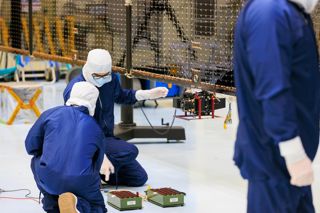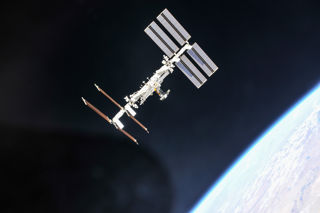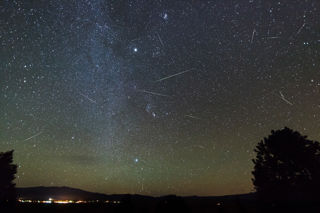
What's Happening in Space: October 2024
- 30th Sep 2024
- Author: Dhara Patel
A summary of space events through the month
Dhara Patel is a Space Expert at the National Space Centre, working to help share space science, stories, and topical news with our visitors and online audiences. Each month she curates a round-up of some notable space and science events coming up the weeks ahead.
This October sees the launch of the Europa Clipper mission, a supermoon and a chance to spot the peak of the Orionid meteor show - plus much more!
Late September / Mid-October – spot Comet C/2023 A3 (Tsuchinshan-ATLAS)
Whilst astronomers can predict the position of comets, there are no guarantees when it comes to their brightness and therefore naked-eye visibility, due to the different processes responsible for their appearance. However, at the end of September it may be possible to spot Comet C/2023 A3 (Tsuchinshan-ATLAS) in the hour before sunrise. C/2023 A3 has an estimated 80,000-year-long orbit and is expected to reach its closest point to the Sun (perihelion) on 27th September. At that time, it is likely to reach its peak brightness. Trying looking towards the eastern horizon just before sunrise between 27th September and 2nd October to spot the comet. If you have no luck, there are more windows of potential naked-eye visibility in the evening sky from mid-October, after the comet loops by the Sun and begins its journey back out into the solar system. The comet will be lost in the Sun's glare until around 12th October when it will be at its closest point to Earth and will be positioned close to the western horizon. From mid to end of October, try looking to the western horizon after sunset to try and spot the comet - it’ll gradually be getting dimmer, so having a pair of binoculars or telescope to hand is a good idea as it may be difficult to spot. The comet will likely look like a hazy blob – you may catch a tail-like feature if you’re lucky!

Throughout October – spot the International Space Station
There aren’t any ISS sightings from Leicester, where we're based, during the first couple of weeks of October but there may be opportunities later in the month – use NASA’s Spot the Station to find out when and where to spot the largest artificial satellite overhead.
2nd October – new moon (19:49)
The new moon will occur in the constellation of Virgo. The lack of moonlight interference provides a great time to try and view deep sky objects (especially with the aid of binoculars and telescopes). We have a blog on ‘phases of the moon’ written by Mike Darch in our Education team: https://spacecentre.co.uk/blog-post/moon-phases/
5th October – Moon and Venus close in the sky
During the evening of 5th October, the thin waxing crescent moon will be in conjunction (sharing the same right ascension – coordinate) with Venus, but the pair will be below the horizon at this time, so not visible from the UK. Rather, you can try to catch the Moon and Venus in close proximity around sunset in the west, when the pair will be just above the horizon. They’ll be difficult to spot so a clear view without tall buildings or trees that may block your view, will help you spot the pair more easily. The duo will be too widely separated to fit within the field of view of a telescope, but will be visible to the naked eye and possibly through a pair of binoculars together. Find out more about conjunctions and other astronomical phenomena in our blog written by David Southworth in our Education Team: https://www.spacecentre.co.uk/news/space-now-blog/astronomical-phenomena/.
7th October – Hera mission launches
Hera is a space mission of the European Space Agency whose main aim is to study to Didymos-Dimorphos binary asteroid pair, following the impact that NASA’s DART mission made with the moonlet asteroid of this system. The satellite will look at the aftermath of the DART impactor which successfully crashed into the Dimorphos asteroid in September 2022. Hera is due to launch 7th October (15:52 UK-time) from Cape Canaveral, Florida, USA on a SpaceX Falcon 9 rocket and won’t arrive at its destination until October 2026. Check out this blog about the Hera mission written by Ed Turner in our Education Team: https://www.spacecentre.co.uk/news/space-now-blog/hera-esas-mission-to-a-damaged-asteroid/
8th/9th October – peak of the Draconid meteor shower
A relatively weak meteor shower with up to 10 meteors per hour at its peak, it’s produced by dust left behind by Comet 21P/Giacobini-Zinner. Active between 6th-10th October, the shower peaks on the evening of 8th October into the early morning of 9th October. And with the Moon in its waxing crescent phase there will be no moonlight interference (after it sets in the early evening), but it’s still worth viewing from as dark a location as possible. The radiant will appear high in the north-west falling closer to the northern horizon as the night unfolds. Find an open location with clear views facing north and look away from the radiant in the constellation of Draco to scan the entire starry canvas above, as meteors can appear anywhere in the sky. Find out more in our Draconid meteor shower 2024 blog: https://www.spacecentre.co.uk/news/space-now-blog/draconid-meteor-shower-2024/

10th October – Europa Clipper mission launches (17:31)
Europa Clipper is a NASA mission that will conduct a detailed survey of Europa – one of Jupiter’s moons. It will use a sophisticated suite of science instruments to investigate whether the icy moon has conditions suitable for life. The primary mission set to last for four years will produce high-resolution images of moon’s surface, work out what it’s composed of, look for signs of recent or ongoing geological activity, and work out the depth and salinity of Europa's ocean, amongst other things. It will orbit Jupiter but will make nearly 50 flybys of Europa during the mission. Europa Clipper is scheduled to launch 10th October (17:31 UK-time) on a SpaceX Falcon Heavy rocket from Kennedy Space Center, Florida, USA.
In this image, technicians at the Payload Hazardous Servicing Facility at NASA’s Kennedy Space Center in Florida install and test antennas on a solar array for the spacecraft, back in March this year.
We’ll soon have a blog up about the Europa Clipper mission written by Katie Holland in our Space Comms team: https://www.spacecentre.co.uk/news/space-now-blog/europa-clipper/
14th October – Moon and Saturn close in the sky
During the early evening of 14th October, the waxing gibbous moon will be in conjunction (sharing the same right ascension – coordinate) with Saturn and the pair will be at their closest angular separation (close approach) around the same time. From the UK, they’ll be visible above the south-eastern horizon, so look in that direction after the sun sets around 19:00 UK-time, to spot the Moon sitting just below Saturn. The pair will be up throughout the night , travelling westwards until the set in the early hours of 15th October. Clear views without tall buildings or trees that may block your view, are always helpful, but they should be high enough above the horizon to see well. At conjunction, they duo will be close enough to fit within the field of view of a telescope, and will also be visible to the naked eye or through a pair of binoculars. Check out the astronomical phenomena blog linked above to find out more about conjunctions and close approaches.
17th October – full moon (12:26), supermoon
Known as the Hunter’s moon (according to the old Farmers’ Almanac), this full moon is named after the time of year that marks the best time of the year to hunt, as animals would be plump from abundant food throughout the summer. Check out the “Full Moon: Full Facts” blog written by Mike Darch in our Education team to find out more about full moons: https://spacecentre.co.uk/blog-post/full-moon-facts/.
This month’s full moon is also a supermoon (and the best in 2024). Due to the Moon’s elliptical orbit and it’s shifting movement (precession), when a full moon occurs around the time that the Moon is also at its closest position to Earth in its elliptical orbit, we’re treated to a supermoon where our lunar neighbour appears slightly bigger and brighter. The Moon will rise around sunset and move from east to west throughout the night, setting as the sun rises – so will be visible from dusk till dawn.

20th/21st October – peak of the Orionid meteor shower
An average meteor shower with ~ 20 meteors per hour at its peak, produced by dust left behind by Halley’s Comet. This year, the shower peaks on the evening of 20th October into the early morning of 21st October. The waning gibbous moon will rise in the early evening on 20th October and remain above the horizon throughout the night so there will be moonlight interference to contend with. The meteor shower is still worth viewing from as dark a location as possible. The radiant will appear low in the east rising higher into the south-east as the night unfolds. Find an open location with clear views facing east and look away from the radiant in the constellation of Orion to scan the entire starry canvas above, as meteors can appear anywhere in the sky. Find out more in our Orionid meteor shower 2024 blog: https://www.spacecentre.co.uk/news/space-now-blog/orionids-meteor-shower-2024/
21st October – Moon and Jupiter close in the sky
During the morning of 21st October, Jupiter will be in conjunction (sharing the same right ascension – coordinate) with the waning gibbous moon. They will also be at their closest angular separation (close approach) shortly before, but they’ll be up in the daytime sky at this point, so won’t be visible together. Instead, look to the southwest prior to sunrise to spot Jupiter slightly below the Moon in close proximity, before daylight drowns out the light of Jupiter. The duo will be too widely separated to fit within the field of view of a telescope or a pair of binoculars but will be visible to the naked eye. Check out the astronomical phenomena blog linked above to find out more about conjunctions and close approaches.
23rd October – Moon and Mars close in the sky
On the evening of 23rd October, Mars will be in conjunction (sharing the same right ascension – coordinate) with the waning gibbous moon. They will also be at their closest angular separation (close approach) shortly after, but both will be below the horizon at that point so won’t be visible. Instead wait just a little longer and try to catch the Moon and Mars in close proximity just before midnight when they begin rising in the northeast. Mars will be to the right side of the Moon – they’ll be close to the horizon to begin with so an open location with clear views would be helpful, but they’ll rise higher into the sky throughout the night (though will drift further apart as they do). Whilst the duo will be too widely separated to fit within the field of view of a telescope, they will be visible to the naked eye and possibly through a pair of binoculars together. Check out the astronomical phenomena blog linked above to find out more about conjunctions and close approaches.
27th October – daylight savings ends (revert from BST to GMT/UTC)
To make better use of the daylight available in the UK between March and October, an hour of daylight is borrowed from the morning and added to the end of the day, so during those months we follow BST – British Summer Time. As we head into winter we revert to GMT / UTC (Greenwich Mean Time / Coordinated Universal Time) to allow the sunrise to arrive earlier and again make better use of the shorter daylight hours. At 2:00am on Sunday 27th October the clocks will go back to 1:00am – yay, to an extra hour of sleep!
Please note: As this summary is created at the end of the month before, dates (especially launch dates) can often change or be updated, so this content may become outdated - we always recommend checking on the relevant organisation's pages.
